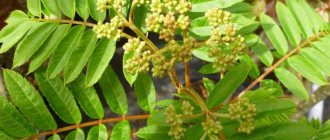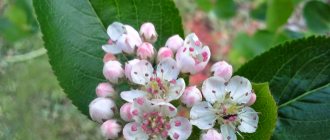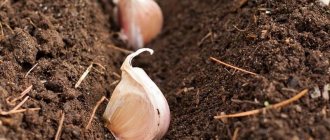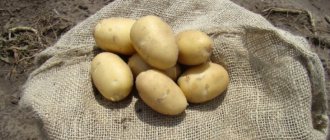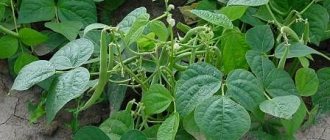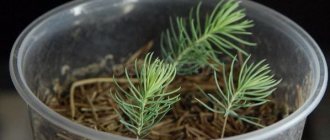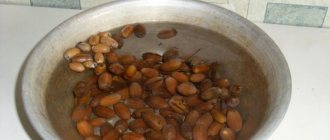Planting rowan in spring
In spring, rowan trees are planted before sap flow begins. When planting at this time of year, the risk of the plant freezing is reduced , as sometimes happens in the fall. The young tree will have time to take root in the soil and will gain strength before winter. In spring, strong winds occur less often, which means that weak shoots will not break, and rodents at this time are not as active as in autumn.
Attention! When you can plant rowan - in spring or autumn, each gardener decides for himself. First of all, it is recommended to pay attention to the growing region, climatic conditions and soil conditions.
Spring planting also has its disadvantages . For example, seedlings are more expensive in spring than in autumn. Summer residents have to constantly check the moisture level in the soil to ensure that the plants feel good. Often after winter there are not enough nutrients in the soil, so it is important to organize additional fertilizing.
Rowan propagation by red grafting
, the split grafting method is most suitable.
. In January, cuttings of the current year are cut, tied into bunches and buried vertically in soil or sand to a depth of 15 cm.
In early spring, an annual seedling is selected for the rootstock, dug up and cleared of soil clods. A 3 cm deep split is made in the upper part of the root. Select a strong cutting with developed buds, and make a double wedge-shaped cut in the lower part of the shoot so that it matches the size of the split. The upper part of the cutting is cut at an oblique angle above the upper bud.
The scion is placed in a split, the junction is wrapped with film, and the top of the scion is treated with garden varnish. The finished grafted seedling is planted in a greenhouse so that the connection point is on the surface of the soil. Sand and peat in equal parts are used as soil. The seedling should not dry out; it is necessary to moisten the soil and air. After successful merging, the seedling is planted in a permanent place in the open ground, cutting off the shoots on the rootstock.
When to plant rowan in spring
Rowan trees are planted after the snow melts . The recommended air temperature is about +7°C; at minus or zero temperatures, the seedlings will freeze. On the day of planting, the weather should be calm and without precipitation.
Some summer residents choose the date in accordance with the lunar calendar . The suitable month for the procedure is April; the optimal days fall on the waxing Moon. During the full or new moon, it is not recommended to plant fruit trees in the garden: it is believed that at this time the plants have weak vitality.
Choosing a landing site
Rowan is a frost-resistant and unpretentious plant ; it takes root in many types of soil, including sandy loam, loamy, mixed. Due to its high growth, places are allocated for the tree in the corners of the site or along the fence.
It is important that the adult plant does not obscure other garden crops . Rowan is planted at a distance of 4-5 m from other trees and tall shrubs. Choose a sunny or slightly shaded place; the location of the groundwater does not matter. Due to its decorative appearance, rowan is successfully used as a beautiful hedge.
Types and varieties of rowan with photos and descriptions
About 90 species of mountain ash have been found in nature. Some are grown for harvest, while others are grown for decorative purposes.
Rowan elderberry sorbus sambucifolia
This tree is common in the Far East. It is a bush up to 2 m tall. The berries reach 1.6 cm in diameter, are juicy, have a sweet and sour taste and a pleasant smell.
Rowan glogovina sorbus torminalis or medicinal bereka
It grows in the Caucasus Mountains, on the Crimean Peninsula, in Turkey and in the southern regions of Ukraine. It grows in small groups or individual trees reaching 20 meters in height. The bark is dark grayish, covered with longitudinal cracks. The fruits are orange or light red, growing up to two centimeters in diameter, gradually changing color to brownish. Does not tolerate long absences of rain.
Rowan sorbus domestica or large-fruited Crimean rowan
It grows slowly, reaching a height of 16 meters. The berries grow up to 3 cm in cross section, are colored red, yellowish-greenish or brownish, have a tart-sweet taste, and contain stony inclusions. Resistant to prolonged absence of moisture and harmful insects.
Rowan roundleaf sorbus aria or aria or mealy rowan
Grows in mountainous areas. Young leaves are felt-white, but as they grow they turn green, and in the fall they take on a bronze color. The spherical berries are sweet and sour, up to 1.7 cm in diameter, their color is pinkish or reddish-orange. Its garden subspecies are known:
- Chrysophylla;
- Majestic;
- Decaysne;
- Manifika;
- edible.
Hybrid rowan sorbus x hybrida
The plant is the result of crossing two species of trees. The Thuringian variety, bred by hybridizing red rowan with round-leaved rowan, is popular among gardeners.
Common red rowan
The most common type of plant, which has a long list of decorative subspecies that serve as decoration for the surrounding landscape throughout its growing season. Trees differ in the shape of their crowns, shades of leaves and berries. Among the decorative forms of the plant, the most famous can be mentioned:
- Moravian (sweet);
- pyramidal;
- Burka;
- liqueur;
- Beisner;
- Michurinskaya dessert;
- pomegranate;
- Fifeana;
- Russian;
- crying.
The best varieties of red rowan
The most popular varieties are:
- Solar;
- Titanium;
- Shimi Glow;
- Germins;
- Fastigiata;
- Sorbinka;
- Wefed;
- Red Type, etc.
Rowan in landscape design
These trees are often used to decorate the landscape. They look great both isolated and in combination with other fruit and berry plantings. In autumn, they will stand out very favorably with their brightness against the background of monochromatic coniferous crops.
Weeping plant species can be used to decorate arches or gazebos. And with the help of shrub forms planted along the fence, a rowan hedge diluted with flowers will look beautiful. Rowan will highlight the beauty of red viburnum, rose, barberry and bird cherry growing nearby.
Preparation of seedlings
Rowan seedlings are bought in specialized stores. They should be strong and elastic, with a moist root system consisting of 3-4 branches . The bark should be smooth, without wrinkles. If wrinkled areas are visible, it means the plant has been overdried.
Advice! During transportation, the roots of the seedlings are wrapped with a damp cloth.
Before planting, the roots are placed in a clay mash . It eliminates germs and bacteria and serves as an effective antiseptic. It is made from water, clay, mullein, water and ash. The roots are dipped in the mixture and placed in sawdust, which acts as mulch and retains moisture. Afterwards, the root system is wrapped in a thick plastic bag or burlap.
Soil preparation
How to fertilize garden soil before planting? For rowan, prepare sandy or loamy soil with a neutral reaction . A drainage layer made of expanded clay is welcome: it retains moisture and protects the rowan from insect pests. Before planting, the soil is fertilized: a bucket of compost, 150 g of superphosphate and 300 g of wood ash are added. If there are large clods in the ground, they are broken up with a shovel or rake. The planting site must be clean, free of weeds and last year's leaves.
Interesting things on the site:
Reproduction of viburnum Buldenezh in spring by cuttings
Planting blueberry seedlings in open ground in spring
How to plant rowan in spring
The pit is prepared 2-3 weeks before the planting date . The average depth is 70 cm, the diameter is equal to the size of the root system. On the day of planting, pour a bucket of water into the hole and wait until it is absorbed.
Take a seedling, straighten the roots and place it in a recess so that the root collar is located at a distance of 5–7 cm above ground level . The soil is compacted around the plant and the base is sprinkled with mulch made from sawdust, peat or humus. The thickness of the layer is about 5–10 cm. When filling the hole, carefully shake off the tree so that no air pockets arise.
Planting scheme and neighboring crops
Rowan berries are planted singly or in small groups of 3-4 trees . Several plants make a beautiful background for plantings of perennial shrubs. The distance between rowan and other crops should be at least 4 m. Otherwise, the plants will take nutrients from each other, which will cause the yield to suffer.
What to plant next to viburnum? It is not recommended to plant apple or pear trees nearby. Favorable neighbors for rowan are viburnum or barberry, coniferous trees and shrubs.
Nuances of planting depending on the growing region
In areas with hot and long summers, the plant is planted in partial shade . This will protect it from the scorching sun and improve its appearance. Otherwise, moistening the rowan will take 2-3 times more water than under normal conditions, and if there is a lack of moisture, the leaves will be dry and the fruits will be small.
If the tree is grown in the northern regions (in the Urals and Siberia), special attention is paid to the growing area and soil preparation. To improve its quality, complex fertilizing is applied to the hole before planting. They saturate the soil with microelements, which help the roots take root in a new place. It is recommended to use Agros complex fertilizer, enriched with nitrogen, phosphorus and potassium.
To grow rowan in regions with humid summers, choose soil with a neutral reaction. The bottom of the planting pit is covered with a drainage layer, crushed stone or expanded clay is used. If drainage is not created, the water will stagnate, which will lead to the development of fungal diseases and the appearance of insect pests.
Depending on the types of rowan
There are several types of rowan. Red prefers moist areas . In dry soils it grows slowly and is not distinguished by its lush crown and bright berries. Common rowan bears fruit well in well-lit and spacious gardens. There should be no tall country buildings or other trees nearby.
Chokeberry , or chokeberry , has a highly branched root system - moisture-permeable and light soils are provided for seedlings.
In heavy soil, the plant will lack air and moisture. If the soil has an acidity above 3.5 pH, it is limed: the top layer is sprinkled with lime or dolomite flour. The branches of the shrubs are lush and heavy, so a peg is placed in the ground during planting. Subsequently, the plants are tied to a support.
Common rowan: cultivation and care
Rowan is very beautiful both during flowering and with clusters ripened on the branches. The berries last a long time on the tree, are not afraid of frost, and are tasty in the form of juices, jellies, jams, marmalades, marshmallows, or simply ground with sugar. You can even prepare homemade medicine using them. Therefore, many gardeners are interested in having at least one rowan tree on their plot. It is a classic of the Russian landscape. And the ancient Slavs attributed the ability to rowan to protect the farmstead from all evil spirits.
Planting and growing mountain ash.
It is possible to grow rowan in the most ordinary soil, but in light soil the tree will grow worse and produce less yield than it could. It is best to plant rowan in the fall. A planting hole measuring 60 x 60 cm is filled with fertile soil, about 5 kg of peat compost or humus, 100 g of potassium fertilizer and 200 g of superphosphate are added to it. The easiest and fastest way to get a seedling is to graft a bud or cutting onto a seedling of any type of rowan. This can also be done using layering, grafting, seeds and root suckers.
You can grow rowan from freshly picked berries, which are picked when they begin to turn brown. They need to be freed from pulp. The seeds must remain moist until autumn sowing. Make shallow grooves in the soil, cover them with humus, deepening them by one and a half centimeters. Plant in a well-lit area. When the seedlings grow up, transplant them to a permanent place. During the care process, form a trunk up to 80 cm in height and plant a couple of cuttings into its upper part, from which you will later form a crown. The technique of grafting a rowan tree is done in the same way as on an apple tree.
Rowan care, crown formation and pruning.
After this, all care comes down to weeding the weeds in a timely manner, removing rootstock, applying fertilizers, watering and loosening the soil. It would also be a good idea to mulch the tree trunk circle (cover it with straw, pine needles, dried grass). Before fruiting begins, a puddle should form in the tree trunk circle from watering - this is the advice of experienced summer residents. Layering is done if the mother tree has a low-standard shape, which makes it easy to bend the branches to the ground. Grafted plants will produce fruits in 2-4 years. It is advisable to plant or graft at least a couple of varieties so that they cross-pollinate. Pruning is done to ensure even illumination of the tree, therefore, for a larger harvest. Since the crown of the rowan tree is pyramidal, and the branches extend from the trunk at an acute angle, this has a bad effect on their strength. Therefore, when forming the main skeletal branches, try to bring them out at an obtuse or right angle.
Pruning is carried out in early spring before the buds swell. In young trees, shoots are slightly shortened to the outer bud, shoots that extend at an acute angle and excess ones are removed. For varieties that bear fruit on last year's growth, the branches are thinned out and shortened slightly. If the growth is weak, rejuvenating pruning of two or five year old wood will help. Rowan, onto which several varieties have been grafted, have their semi-skeletal branches shortened, and in the most productive years the ringlets (the smallest branches) are thinned out. Rowan shoots grow quite quickly; almost all of them ripen by winter.
Varieties of red rowan
There are many varieties of red rowan, but at home the sweet-fruited species are more interesting for growing:
The Russian or liqueur variety was bred by Michurin - he crossed the common forest rowan with the chokeberry. It has high winter hardiness and productivity. Large fruits up to 15 mm in diameter, almost black. Mainly used for making liqueurs, tinctures and jams.
Rowan is very common throughout Central Asia and grows in Crimea.
It is distinguished by very large green fruits the size of plums. The tree is very tall - almost 15 m in height.
Further care
Overgrowth quickly forms at the root collar of the rowan , so gardeners regularly remove it with a hoe or by hand. They also monitor the formation of weeds that actively germinate in wet weather. To slow down their development, once a week the soil is loosened to a depth of no more than 5 cm. At the same time, the tree trunk circle is mulched with hay, grass, pine sawdust and leaves. Mulch prevents the development of insect pests, improves the condition of the earth's microflora, and protects against drought and frost.
In the first 2-3 weeks after planting, the seedlings are watered generously with water at room temperature . This is done in grooves dug at a distance of 20 cm from the plant. One young rowan requires about 8 liters of water. If it rains often, the amount of moisture is reduced.
Attention! Rowan is fertilized only from the third year of life. At first, the plant needs complex fertilizers, which are placed in the hole when planting.
In the first year, it is important to carry out preventive measures to protect the crop from diseases and pests. Common insects - aphids, midges, sawflies, common diseases - anthracnose, gray and white spots, scab. For spring treatment, Oxychom or Abiga-Pik products are used. Contact fungicides are designed to combat viral and fungal diseases and pests.
Features of the rowan tree
The duration of the plant's growing season is from 80 to 200 years. It usually grows as a tree or shrub no higher than 10 m, but in mountainous areas low-growing specimens can also be found.
The crown has a dome shape. The bark is yellowish-gray or brownish, shiny and smooth. The leaf blade of an adult tree is 20 cm long and includes 7–15 oblong leaves with a serrated edge. In summer the foliage is green; in autumn its color turns golden-red.
Flowering period is late May and early June. Whitish small flowers are united in lush inflorescences, the diameter of which is about 12 cm. The berries ripen in the last days of August or in the first weeks of September. They are represented by juicy orange or red apples with a tart, sweetish taste. Inside them are small round seeds.
Tips and tricks
To grow beautiful and productive rowan trees, experienced gardeners advise following simple planting and care recommendations. Despite the fact that the plant tolerates moisture well, it is not recommended to plant it in swampy areas or near a pond . The best place is a hilly area in the sun or partial shade.
It is important to choose healthy seedlings with a branched root system for growing . If their appearance indicates that the plant is sick, such planting material will not make a beautiful tree.
Some gardeners make a mistake : after planting, they water the plant with cold water from a pond. This can lead to disease, so only water that has been settled and heated in the sun is used for irrigation. Many people immediately begin to fertilize rowan with mineral or organic fertilizers - it is important to remember that in the first 3 years of its life the tree does not need them.

